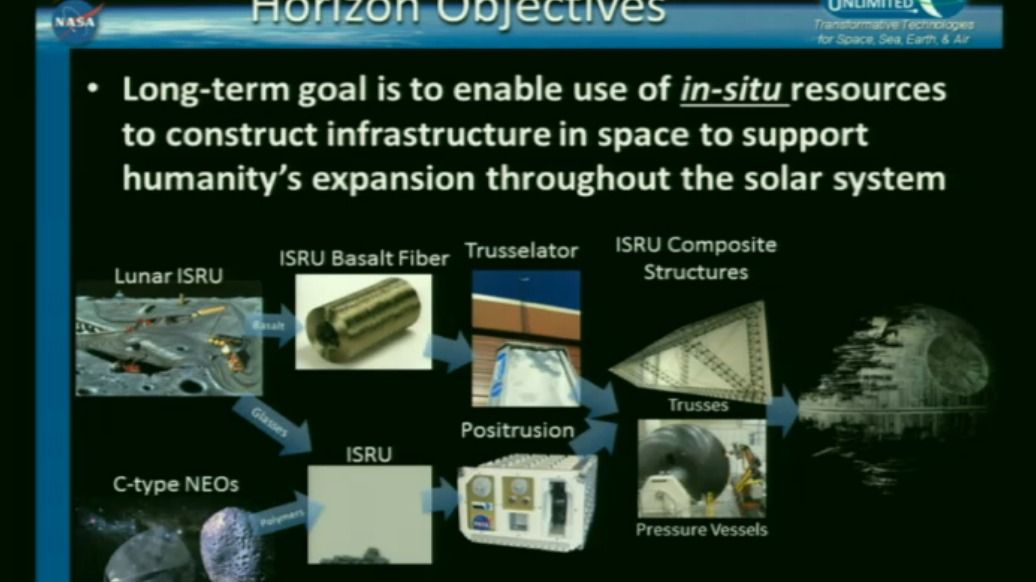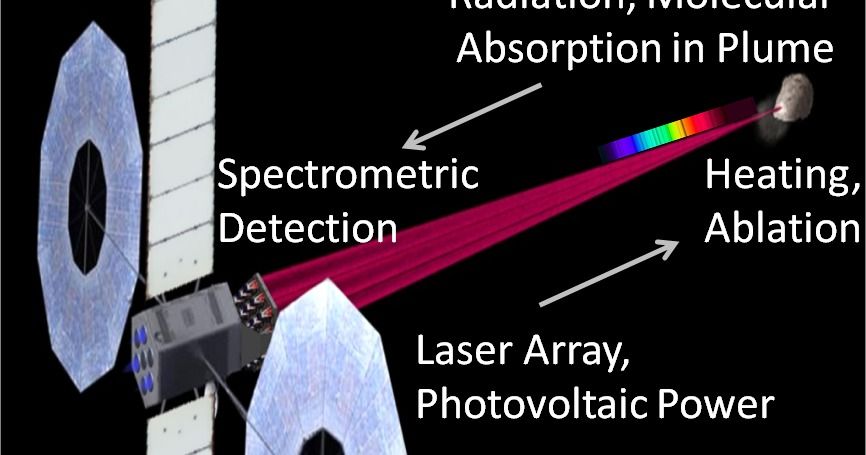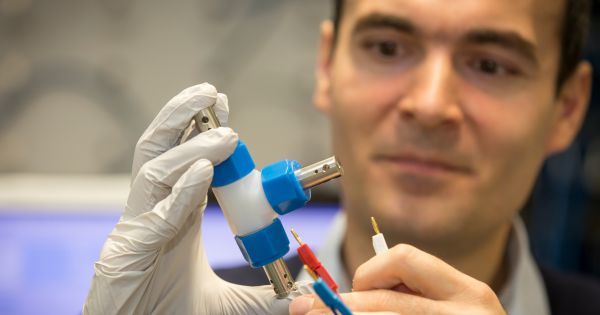Page 10734
Apr 17, 2016
Venus Terraforming Corporation
Posted by Klaus Baldauf in categories: engineering, environmental, space
Apr 17, 2016
Megawatt beam propulsion by 2023 and Gigawatts by 2030
Posted by Andreas Matt in categories: military, space travel
California Polytechnic State University researchers propose a 100 kilowatt space based laser system capable of probing the molecular composition of cold solar system targets such as asteroids, comets, planets and moons from a distant vantage. This system uses existing technology and only some needs refinement. All of it looks achievable in the next 3 to 5 years. They have NASA NIAC funding. They have detailed designs for a 900 kilowatt system that would use two Falcon heavy launches.
The military laser segment will be about a $5 billion per year market by 2020. There is a large multi-billion commercial laser market. Those markets will drive improvements in laser efficiency and technological improvements which will be leveraged for space based systems or ground based lasers for space beam propulsion applications.
Continue reading “Megawatt beam propulsion by 2023 and Gigawatts by 2030” »
Apr 16, 2016
All of the technology is nearly ready for megawatt space based laser systems for science and planetary defense
Posted by Klaus Baldauf in categories: electronics, energy, science, space travel
California Polytechnic State University researchers propose a system capable of probing the molecular composition of cold solar system targets such as asteroids, comets, planets and moons from a distant vantage.
Their concept utilizes a directed energy beam to vaporize or sublimate a spot on a distant target, such as from a spacecraft near the object. With sufficient flux, our published results indicate that the spot temperature rises rapidly, and evaporation of materials on the target surface occurs (Hughes et al., 2015; Lubin and Hughes, 2015; Lubin et al., 2014). The melted spot serves as a high-temperature blackbody source, and ejected material creates a molecular plume in front of the spot. Molecular and atomic absorption of the blackbody radiation occurs within the ejected plume. Bulk composition of the surface material is investigated by using a spectrometer to view the heated spot through the ejected material. They envision a spacecraft that could be sent to probe the composition of a target asteroid, comet or other planetary body while orbiting the targeted object. The spacecraft would be equipped with an array of lasers and a spectrometer, powered by photovoltaics. Spatial composition maps could be created by scanning the directed energy beam across the surface. Applying the laser beam to a single spot continuously produces a borehole, and shallow sub-surface composition profiling is also possible.
Their initial simulations of laser heating, plume opacity, material absorption profiles and spectral detectivity show promise for molecular composition analysis. Such a system has compelling potential benefit for solar system exploration by establishing the capability to directly interrogate the bulk composition of objects from a distant vantage. They propose to develop models, execute preliminary feasibility analysis, and specify a spacecraft system architecture for a hypothetical mission that seeks to perform surface molecular composition analysis and mapping of a near-earth asteroid (NEA) while the craft orbits the asteroid.
Apr 16, 2016
Photon Propulsion Could Launch Spacecraft To Mars In Days
Posted by Klaus Baldauf in categories: energy, physics, space travel
Scientists say recent advances in laser propulsion technology could make it possible for spacecrafts to reach Mars in as little as 3 days using photon propulsion.
The concept was shared by Philip Lubin, a physics professor at the University of California, Santa Barbara at the NASA Innovative Advanced Concepts (NIAC) symposium. Ultimately, the method seeks to place an ultra-powerful laser in Earth’s orbit, that would use photon pressure to power a “sail-equipped” spacecraft. [ESA To Build “Moon Village” by 2030].
Apr 16, 2016
Stephen Hawking: Human Aggression Could ‘Destroy Us All’
Posted by Aleksandar Vukovic in categories: existential risks, space travel
I couldn’t agree more…aggression and recklessness.
Stephen Hawking may be getting some Hollywood love for “The Theory of Everything,” a biopic about his life that earned actor Eddie Redmayne the best actor Oscar at last night’s Academy Awards. But that hasn’t stopped the world-famous physicist from issuing yet another warning about humanity’s impending doom.
Human aggression threatens to destroy us all, Hawking said during a tour of London’s Science Museum last week. The remark was in response to a question about what human shortcomings he would most like to alter. Hawking suffers from a neurological disease similar to Lou Gehrig’s disease, or amyotrophic lateral sclerosis (ALS).
Continue reading “Stephen Hawking: Human Aggression Could ‘Destroy Us All’” »
Apr 16, 2016
SolaBat: A Hybrid Solar Cell and Battery System
Posted by Shailesh Prasad in categories: solar power, sustainability
SolaBat is developing a hybrid device that utilizes both solar cells and more traditional electrochemical energy storage systems.
Last month, the Austrian Research Promotion Agency (FFG) announced a groundbreaking new project called SolaBat. Spearheaded by a group of researchers at the Graz University of Technology (TU Graz) led by Illie Hanzu, it aims to combine photovoltaic cells and electrochemical energy storage systems into a single hybrid device. Fundamentally, SolaBat plans to create a more simplified system of converting and storing solar power.
“Currently, single systems of photovoltaic cells which are connected together – mostly lead-based batteries and vast amounts of cable – are in use. Solar panels on the roof with a battery in the cellar. This takes up a lot of space, needs frequent maintenance and is not optimally efficient,” says Hanzu. “We want to make a battery and solar cell hybrid out of two single systems which is not only able to convert electrical energy but also store it.”
Apr 16, 2016
Novel miniaturized circulator opens way to doubling wireless capacity
Posted by Karen Hurst in categories: computing, internet, military
Re-inventing the integrated circuit.
Since the advent of the integrated circuit in 1958, the same year the Advanced Research Projects Agency was established, engineers have been jamming ever more microelectronic integration into ever less chip real estate. Now it has become routine to pack billions of transistors onto chips the size of fingernails.
DARPA (the D for Defense was first added in 1972) has played key roles in this ongoing miracle of miniaturization, giving rise to new and sometimes revolutionary military and civilian capabilities in domains as diverse as communication, intelligence gathering, and optical information processing. Now a DARPA-funded team has drastically miniaturized highly specialized electronic components called circulators and for the first time integrated them into standard silicon-based circuitry. The feat could lead to a doubling of radiofrequency (RF) capacity for wireless communications—meaning even faster web-searching and downloads, for example—as well as the development of smaller, less expensive and more readily upgraded antenna arrays for radar, signals intelligence, and other applications.
Continue reading “Novel miniaturized circulator opens way to doubling wireless capacity” »
Apr 16, 2016
How bots will change the Web, according to a bot we built to answer that question
Posted by Karen Hurst in categories: 3D printing, business, cybercrime/malcode, finance, internet, robotics/AI, transportation
I am still not convinced that everyone fully understands how bot technology is about to change IoT and its impact to online business industry. Let me share a few ideas: Financial Auditing and accounting. Bots will be able to do a more thorough job in managing, tracking, reporting financials that many finance back office controls can be performed by bots and requiring a sign off by CFO/ Lead Controller. And, Accounting & Audit firms can easily leverage the technology to perform audits on companies remotely without having to send teams of auditors to a client’s site.
Here’s another one; I decide to set up a few 3D printers to make some unique seals for aircraft manufactures for their jets/ planes; and I need a call center plus online sales teams taking and processing orders. With bot technology my whole operation is automated and no need for sales people, call center folks, or operators. All I need is myself and couple of techies to manage the bot operations; and more profit for me and my team.
However, we still have to keep a tight oversight on hacking which is still a risk; however, we should see more micro-size companies spin up as a result of online bots and 3D printers in our immediate future.
Apr 16, 2016
Micro spaceships powered by lasers to search for alien life
Posted by Karen Hurst in categories: alien life, computing, internet, mobile phones, robotics/AI, space travel
Microscopic spaceships powered by Earth-based lasers are being developed to hunt for extra-terrestrial life in Alpha Centauri, the closest star system to ours.
The £70m Breakthrough Starshot concept involves creating a tiny robotic spacecraft, no larger than a mobile phone chip, which would carry cameras, thrusters, a power supply and navigation and communication equipment.
Physicist Stephen Hawking, Facebook founder Mark Zuckerberg and Russian internet billionaire Yuri Milner have all joined the project’s board giving it major backing.

















